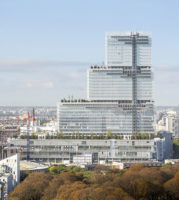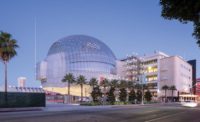Auraria Bike Pavilions by Colorado Building Workshop
Denver

Auraria Bike Pavilion at Curtis Street. Photo © Jesse Kuroiwa
Architects & Firms
Established more than a decade ago, the Colorado Building Workshop, a design-build program at the College of Architecture and Planning at the University of Colorado Denver (CU Denver), has won numerous AIA awards for work that demonstrates the innovative use of common building materials. Led by architect and assistant professor Erik (Rick) Sommerfeld, its portfolio includes housing on the Navajo Nation, cabins for the Colorado Outward Bound School, and what may be the best-looking outhouses in the United States—four steel-and-stone privies that appear to emerge from the rugged landscape on the Longs Peak trail in Rocky Mountain National Park.
The graduate-level workshop’s latest project is closer to home. Completed during the pandemic, the Auraria Bike Pavilions are located in downtown Denver, on the campus of the Auraria Higher Education Center, home to CU Denver, Metropolitan State University, and the Community College of Denver.
The project began in 2019, when Chris Herr, sustainability officer for Auraria’s Sustainable Campus Program, approached Sommerfeld about designing a pair of bicycle-storage facilities for the mostly-commuter campus. Getting around on two wheels is already popular, but Herr wanted to encourage even more nonmotorized transportation, while also combating bike theft, which is rampant on the campus. (Ironically, a bike belonging to one of Sommerfeld’s students was stolen on the very first day of construction.)

1
A pavilion at Curtis Street (1 & 2) offers secure bike storage. Photos © Jesse Kuroiwa, click to enlarge

2
Working in teams, the workshop’s 25 students met often (but virtually) with the client and eventually arrived at a simple yet elegant design for the pavilions, which are located near high-use buildings on campus. Each is constructed with louvered walls made of limestone and steel mesh. The plan allows daylight to enter the buildings from the sides, while also permitting users to peer in to see if there are available spaces for bikes. A flat, 4-inch-thick cross-laminated timber roof spans the 16-foot width of both structures.
At the entrance of each pavilion, a graphic image of a hanging bicycle makes clear what the buildings are for. The facilities, accessed by registered users with key cards, hold 50 bicycles apiece and a few skateboards, and contain fix-it stations with tools and pumps.
The workshop students used Tally, a Revit plug-in developed by architecture firm KieranTimberlake, to assess the pavilions’ environmental impact. “It helped guide our decision to use cross-laminated timber [CLT] for the roofs instead of traditional framing,” Sommerfeld says. The buildings aren’t exactly temporary, but they were designed to be easily disassembled and the materials recycled if they ever become obsolete or need to be replaced with other structures. For that reason, the limestone blocks are dry-stacked and the CLT panels unmodified.
The students, wearing masks and working with building professionals, began construction last August. “Very few of them had experience,” Sommerfeld says, “but the advantage of doing small buildings is that they’re not overly complicated. We’re not trying to make the students into builders but rather to have an appreciation for people that they’ll be working with.”
Recent graduate Cecilia Richey, who had previously done a few DIY projects around the house, found herself lifting 40-pound limestone blocks and learning how to weld. “The workshop was the highlight of the master’s program,” she says. “You learn much more by doing than by just drawing.”
Herr, who’s had two bikes stolen from the Auraria campus, is thrilled with the pavilions. “I think they look amazing,” he says. “They’re better than anything I could have imagined.” He expects them to get plenty of use starting this month, when students return to the campus (largely empty during the pandemic). He’s already fielding inquiries about them. “Hopefully, they’ll encourage more students to commute on bikes. That’s the idea.”
Click plan to enlarge

Credits
Architect:
Colorado Building Workshop — Will Koning, Šárka Malošíková, Paul Stockhoff, design team
Engineers:
Andy Paddock (structural); AE Design (electrical)
General Contractor:
Colorado Building Workshop
Consultants:
Design Workshop (landscape); MH Companies (lighting); TMW Stonemasons (stone); Front Range Roofing (roofs); Justin Morse, Ricky Ludeman (welding); RAW Creative (fabrication); Ellis Construction, Brannan Concrete, Brundage Bone (concrete)
Client:
Auraria Sustainable Campus Program
Owner:
Auraria Higher Education Center (AHEC)
Size:
3,000 square feet
Cost:
$200,000
Completion Date:
November 2020
Sources
Masonry:
Indiana Limestone
Perforated Metal Panels:
Peterson
Cross-Laminated Timber:
SmartLam
Roofing:
Carlisle
Fasteners:
Simpson Strong Tie
Pivot Hinges:
FritzJurgens
Coatings:
Tnemec
Lighting:
Beulux; Hubbell; Wattstopper
Building Software:
Tally



